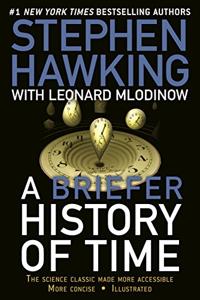
Want to learn the ideas in A Briefer History Of Time better than ever? Read the world’s #1 book summary of A Briefer History Of Time by Stephen Hawking, Leonard Mlodinow here.
Read a brief 1-Page Summary or watch video summaries curated by our expert team. Note: this book guide is not affiliated with or endorsed by the publisher or author, and we always encourage you to purchase and read the full book.
Video Summaries of A Briefer History Of Time
We’ve scoured the Internet for the very best videos on A Briefer History Of Time, from high-quality videos summaries to interviews or commentary by Stephen Hawking, Leonard Mlodinow.
1-Page Summary of A Briefer History Of Time
Look Up in Wonder
As you look at the distant stars, you may wonder what their purpose is. You may also ask yourself where they came from and where they’re going. Are there answers to these questions? In ancient times, people thought the earth was flat. However, as time went on we realized that it’s actually round and ships appear over the horizon gradually because of this shape. The Greeks observed how some lights in the sky moved differently than others; those were planets such as Mercury, Venus and Mars (which are closer to us).
The ancients had a variety of models to explain the universe. Aristotle believed that the Earth was stationary and everything else moved around it in circular orbits. Ptolemy argued for nested spheres with stars on them, which explained how planets moved around the sun. The model wasn’t very accurate but it gave people a way to predict what would happen in space. Copernicus later said that the planets orbited around the sun instead of moving through these spheres, but most people didn’t accept this new idea until Kepler and Galileo’s observations supported it. Newton then showed why all these things happened by explaining gravity as well as motion laws in his Principia, “one of the most important books ever written.”
Scientific Theory and Fact
In order to discuss the great questions of life, you need to understand what a scientific theory is. A good theory should have rules that describe how things work in the model and let you make predictions about what you will see in reality. Empedocles’ idea that everything was made up of four elements (earth, air, fire and water) did not allow him to make any accurate predictions. Aristotle’s ideas were even simpler; he argued that all objects attract one another based on a force determined by their mass and distance from each other. No matter where an object is placed or its size, this single theory allows us to predict celestial movement with extreme accuracy.
All scientific theories are provisional. No one can prove them because they’re always open to new evidence. A single contradiction can disprove a theory, but the more times it’s been proven, the more people trust it. New theories often extend and modify existing ones without disproving them. For example, Einstein’s and Newton’s predictions about Mercury were slightly different, but both proved true in observations of that planet; therefore neither theory was entirely correct or incorrect.
Galileo and Newton
Galileo was one of the first thinkers to argue that humans could understand how the world works by observing nature. He suffered from the Catholic Church’s Inquisition and arrest for his ideas, but he helped provide an alternative to Aristotle’s model of the physical world. In this model, heavier objects should fall faster than lighter ones; however, Galileo demonstrated that they fell at same rate when rolling down a slope.
Newton built on the work of earlier scientists by describing how objects move without being influenced by outside forces. He argued that if an object is not affected by a force, it will continue in a straight line at the same speed. In addition, he stated that if there is an interaction between two objects, they will change their speeds depending on the strength of that force. Newton also explained gravity as a universal law and showed how gravity varies based on distance between two objects.
Aristotle believed that the Earth was at rest, which is different from Newton’s laws. The difference matters because it means that there is no absolute standard of rest in the universe. This conclusion has implications for physics and astronomy, because it negates the idea of “absolute position.” It also suggests that observers can see things differently in physical reality and never resolve their differences. Both Aristotle and Newton agreed on a single “absolute time” that scientists could measure until the 20th century.






